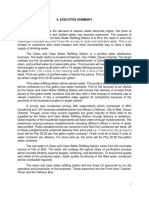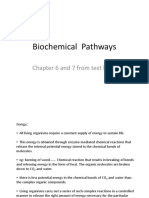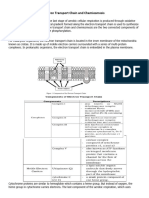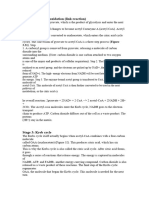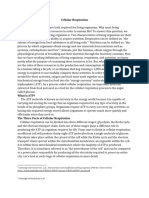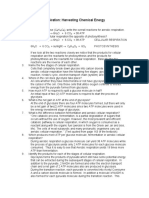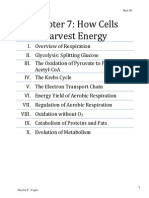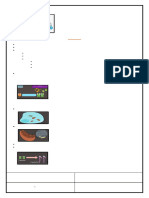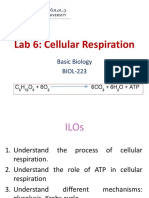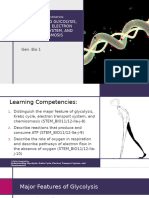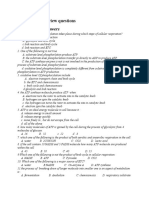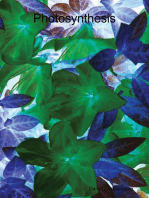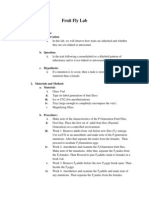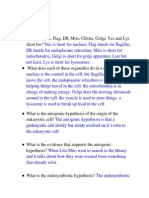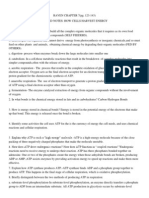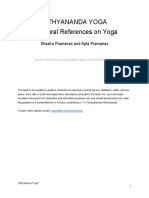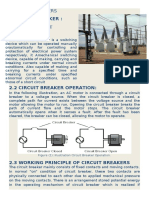Ch. 7 Pre Reading Questions
Ch. 7 Pre Reading Questions
Uploaded by
DJ ISAACSCopyright:
Available Formats
Ch. 7 Pre Reading Questions
Ch. 7 Pre Reading Questions
Uploaded by
DJ ISAACSOriginal Description:
Copyright
Available Formats
Share this document
Did you find this document useful?
Is this content inappropriate?
Copyright:
Available Formats
Ch. 7 Pre Reading Questions
Ch. 7 Pre Reading Questions
Uploaded by
DJ ISAACSCopyright:
Available Formats
RAVEN CHAPTER 7(pg. 123-143) GUIDED NOTES: HOW CELLS HARVEST ENERGY 1. Define the following terms a.
autotrophs- An organism able to build all the complex organic molecules that it requires as its own food source,using only simple inorganic compounds (SELF FEEDERS). b. heterotrophs-An organism that cannot derive energy from photosynthesis or inorganic chemicals,and so must feed on other plants and animals, obtaining chemical energy by degrading their organic molecules (FED BY OTHERS). c. digestion- process when enzymes break down the large molecules into smaller one d. catabolism- In a cell,those metabolic reactions that result in the breakdown of complex molecules into simpler compounds,often with the release of energy. e. aerobic respiration - The process that results in the complete oxidation of glucose using oxygen as the final electron acceptor. Oxygen acts as the final electron acceptor for an electron transport chain that produces a proton gradient for the chemiosmotic synthesis of ATP. f. anaerobic respiration- The use of electron transport to generate a proton gradient for chemiosmotic synthesis of ATP using a final electron acceptor other than oxygen. g. fermentation- The enzyme catalyzed extraction of energy from organic compounds without the involvement of oxygen. 2. In what bonds is the chemical energy stored in fats and in carbohydrates? Carbon-Hydrogen Bonds 3. How is energy stored in chemical bonds? Energy is stored in the potential energy of the electrons that make up that bond. This energy is released once the bond is broken. 4. Identify some activities the cell uses ATP for.the is the currency of energy the cell needs, and uses chemical reactions and cellular respiration. 5. Explain why ATP is such a high energy molecule.-ATP is a high-energy molecule because of the close packing of three negatively charged phosphates that make the molecule unstable. 6. How does ATP drive endergonic reactions? How does ATP function in coupled reactions? Endergonic reactions need to receive energy to undergo their reaction. ATP has three phosphates bonded together on adenosine. One or two of the phosphates create the energy when those anhydride bonds are broken, producing ADP or AMP.;ATP assists enzymes by providing activation energy to speed up reactions and make them more effective. 7. Explain how ATP synthase produces ATP.-ATP synthase binds ADP and a phosphate group together to produce ATP. This happens in the final stage of cellular respiration, which is oxidative phosphorylation. 8. Briefly distinguish between the two methods of producing ATP in respiration: a. substrate-level phosphorylation-In substrate-level phosphorylation, an enzyme directly transfers a phosphate group to ADP from an intermediate substrate. All ATP production in glycolysis occurs by substrate-level
phosphorylation; this form of ATP production also occurs at one step in the citric acid cycle. b. aerobic respiration-The aerobic respiration is a high energy yielding process. During the process of aerobic respiration as many as 38 molecules of ATP are produced for every molecule of glucose that is utilized. Thus aerobic respiration process breaks down a single glucose molecule to yield 38 units of the energy storing ATP molecules. 9. List the four stages of cellular respiration: a. Glycolysis Process occurs in the cytoplasm; A six-carbon glucose molecule is converted to two, 3-carbon molecules of pyruvate This process occurs in the cytoplasm. In order to initiate the process, 2 molecules of ATP are consumed. Four molecules of ATP and 2 molecules of NADH are produced; b. Formation of acetyl coenzyme A Process involves shuttling pyruvate molecules into mitochondria Each pyruvate molecules is oxidized to carbon dioxide and a 2-carbon acetyl group. The carbon dioxide is released as a waste product, and the 2-carbon acetyl group is bound to coenzyme A and brought into the mitochondrion; c. The citric acid cycle Each of the 2-carbon acetyl groups produced from the original glucose molecule is bonded to a preexisting molecule of oxaloacetate to form citrate (i.e. citric acid). These two citric acid molecules are gradually oxidized, and the hydrogen ions are bound to NAD to form NADH and to FAD to form FADH2. Oxaloacetate is produced when the last carbon atom is released in the form of carbon dioxide; Two ATP molecules are synthesized for each glucose molecule entering the cell. d. Electron transport chain and chemiosmosis The electrons removed from the molecules in glycolysis and citric acid follow a series of cytochromes on the mitochondrial membrane, Hydrogen ions (protons) are pumped across the inner membrane of the mitochondrion. These protons flow through ATP synthase enzyme molecules, and thereby release energy which drives the formation of 34 ATP molecules. 10. List two classes of prokaryotes that utilize anaerobic respiration and explain what molecules they use as electron acceptors (instead of oxygen). a.In anaerobic environments sulfate serves as terminal electron acceptor and is reduced to sulfide, giving rise to both the formation of metal sulfides in sediments and the evolution of hydrogen sulfide gas. b.Carbon dioxide is used as terminal electron acceptor by methanogenic Archaea for energy generation, yielding methane as final product and by different groups of prokaryotes to produce acetate. 11. STAGE 1: Glycolysis a. occurs where? occurs in the cytoplasm
b. starts with? 2 molecules of ATP are consumed. c. produces?Four molecules of ATP and 2 molecules of NADH are produced; d. yields how much ATP? six-carbon glucose molecule is converted to two, 3-carbon molecules of pyruvate e. produces ATP through what process? 2 molecules of ATP are consumed 12. Why is glycolysis thought to be one of the earliest of all biochemical processes to have evolved? Glycolysis is the most widespread metabolic pathway. 13. STAGE 2: Oxidation of Pyruvate a. occurs where? occurs in the inner membrane of the mitochondria. b. starts with? It starts with c6h1206 (glucose), oxygen and 2 atps. The glucose is broken into 2 3-carbon molecules, is oxidized to pyruvate which gives 2 atps. c. produces? NADH and FADH2 d. yields how much ATP? yields 38 atps. 14. If the body has enough ATP, what is the fate of acetyl-CoA? It produces a small amount of ATP and the three-carbon compound pyruvate. ... CO2 and H2O; the fate of the released electrons is described in the next section. One of the most important molecules in the body undoubtedly is adenosine ... The conversion of pyruvate (product of glycolysis) to acetyl CoA (one of the starting ... 2 molecules of ATP are invested to produce pyruvate, which is useless if PDC is not functioning properly.6 At this point, the pyruvate molecule has many fates. 15. STAGE 3: The Krebs Cycle a. occurs where? mitochondrial matrix b. starts with? The citric acid cycle begins with acetyl-CoA transferring its two-carbon acetyl group to the fourcarbon acceptor compound (oxaloacetate) to form a six-carbon compound (citrate). c. produces? This is the most important link to the electron transport chain where most of the ATP needed for energy reactions is produced. d. yields how much ATP? 2 ATP's, e. produces ATP through what process? by releasing energy stored in glucose and other sugars. 16. What is the major function of the Krebs cycle? The Krebs cycle is also called the citric acid cycle. The Krebs cycle is a series of chemical reactions used by all aerobic organisms. The main function of the Krebs cycle is to generate energy through the oxidation of acetate and turn it into carbon dioxide and water. 17. Define each of the following: a. oxidation-loses an electron b. reduction-gains an electron 18. What are the roles of NAD+ & FAD+2 in respiration? NAD+ and FAD+2 are acceptor molecules that transport electrons
19. STAGE 4: The Electron Transport Chain a. occurs where? b. starts with? c. produces? d. yields how much ATP? e. produces ATP through what process? 20. What is the final electron acceptor in the Electron Transport Chain? 21. Describe the role of the Electron Transport Chain. What happens to the electrons and H+? The Electron Transport Chain is located in the: inner mitochondrial membrane. The electron transport chain creates water. The energy from this water is stored in the mitochondria to later be transformed into ATP. 22. What is chemiosmosis and how is it generated?Chemiosmosis is the coupling of the electron transport chains redox reactions with ATP synthase. It uses energy stored in the H+ gradient.
23. Explain why respiration is considered exergonic.-Through the process of cellular respiration, ATP is produced, therefore the reaction is exergonic. 24. What is the main reason energy is harvested in stages in respiration 25. What happens to most of the energy released during cell respiration? 26. What is the theoretical ATP yield of aerobic respiration? ...the actual yield? Explain why they differ. 27. Identify examples of each of the following feedback mechanisms in aerobic respiration: a. negative feedback -Negative feedback If there is too much ATP in a cell then the process of cellular respiration will slow down so as not to have an overabundance. b. positive feedback28. Write the summary equation for cellular respiration: C6 H12 O6 + 6 O2 6 CO2 + 6 H2O + Energy a. Where did the glucose come from? Where did it go? In plant cells the glucose is manufactured by the chloroplasts. In animal cells the glucose comes from the food the organism eats; b. Where did the O2 come from? Where did it go? The oxygen is either produced during photosynthesis or breathed in by an animals repertory system; c. Where did the CO2 come from? Where did it go? From the breakdown of acetate from oxaloacetate during the Krebs cycle;
d. Where did the H2O come from? Water is a byproduct of the electron transport chain. e. Where did the ATP come from? the use of an existing proton gradient in the inner membrane of the mitochondria. This occurs during the electron transport chain. f. What else is produced that is not listed in this equation?Ammonia is also produced.
I know you cannot write on this diagram but you can label it and draw arrows. You can also add in textboxes.
Glucose is extracted from complex molecules, such as fats, proteins, disaccharides (e.g., sucrose), and polysaccharides (e.g., starch) Energy can be extracted from molecules more complex than glucose such as proteins, carbohydrates and fats. These complex molecules are broken down into monomers, which then enter glycolysis or the citric acid cycle at various positions, Disaccharides and polysaccharides are broken down into glucose for glycolysis; other molecules may require more processing,Amino acids are used directly to create new proteins.
30. What is the fate of these other organic molecules when they are used as fuel molecules:
a. Proteins-Proteins are broken down into amino acids, which are used by the cell to make new proteins; excess amino acids are converted for use in glycolysis or the citric acid cycle following deamination.
b.Fats-are broken down into glycerol and fatty acids. Fatty acids contain most of the energy in fats. Fats store almost twice as much energy as carbohydrates.
31. Fermentation a. Alcoholic fermentation converts glucose to ethanol and energy for the cell. b. Alcoholic fermentation is utilized by what organisms? Bacteria and yeast c. Lactic acid fermentation converts glucose to Lactic Acid Glucose goes through glycolysis, pyruvic acid is made, and it is converted to lactic acid d. Lactic acid fermentation is utilized by what organisms?It is utilized by animals that use this process when oxygen is scarce. One example is muscle cells 32. Big Picture Thought Questions a. Why do we eat?We eat to gain the glucose necessary to undergo cellular respiration. b. Why do we breathe? Breathing provides the oxygen needed for cellular respiration and expels the carbon dioxide that is produced during the reaction.
You might also like
- Business Plan - C2 Water Refilling Station-1 (1) .3Document51 pagesBusiness Plan - C2 Water Refilling Station-1 (1) .3Roxette Marie84% (43)
- Earth and Life Science ModuleDocument112 pagesEarth and Life Science ModuleAlessandro Silva83% (235)
- Biology: a QuickStudy Laminated Reference GuideFrom EverandBiology: a QuickStudy Laminated Reference GuideRating: 3 out of 5 stars3/5 (2)
- STPM BIOLOGY RespirationDocument14 pagesSTPM BIOLOGY Respirationwkwhui75% (4)
- Aerobic Respiration EssayDocument3 pagesAerobic Respiration EssayMelissa WilderNo ratings yet
- Raven Chapter 8 Notes: Energy and MetabolismDocument1 pageRaven Chapter 8 Notes: Energy and MetabolismDJ ISAACSNo ratings yet
- Ellular Espiration Chapter Outline: 8.1 Cellular RespirationDocument4 pagesEllular Espiration Chapter Outline: 8.1 Cellular RespirationKevin RiveraNo ratings yet
- Answer Key Si Worksheet 10Document5 pagesAnswer Key Si Worksheet 10Jersey BarquillaNo ratings yet
- Biochemical Pathways: Chapter 6 and 7 From Text BookDocument46 pagesBiochemical Pathways: Chapter 6 and 7 From Text BookSnehal SinghNo ratings yet
- A2 Biology Notes Cellular RespirationDocument20 pagesA2 Biology Notes Cellular RespirationArnel100% (1)
- Cellular Respiration - A Detailed Overview For Grade 9Document2 pagesCellular Respiration - A Detailed Overview For Grade 9Gian Paolo GerzonNo ratings yet
- Biochemical PathwaysDocument46 pagesBiochemical PathwaysHameed FarisiNo ratings yet
- Cellular Respiration: Using Energy From Food To Make ATPDocument5 pagesCellular Respiration: Using Energy From Food To Make ATPed8widgeNo ratings yet
- Unit Five Last One Grade 11 Biology Energy TransformationDocument55 pagesUnit Five Last One Grade 11 Biology Energy TransformationaxumfunNo ratings yet
- Cellular Respiration Essay QuestionsDocument4 pagesCellular Respiration Essay QuestionsLaila Abdul100% (1)
- Microbiology RevisionDocument27 pagesMicrobiology RevisionShevani KumarNo ratings yet
- Lecture 4 Carbohydrate-GlycolysisDocument20 pagesLecture 4 Carbohydrate-GlycolysisBiology BảoNo ratings yet
- Biology Week 7-8Document5 pagesBiology Week 7-8Clarisse De GuiaNo ratings yet
- Cellular RespirationDocument52 pagesCellular RespirationCici SintamayaNo ratings yet
- Grade 11: Modified Strategic Intervention MaterialDocument19 pagesGrade 11: Modified Strategic Intervention MaterialJake LacanlaleNo ratings yet
- General Biology 1: Quarter 2 - Module 13 To 15: Energy TransformationDocument8 pagesGeneral Biology 1: Quarter 2 - Module 13 To 15: Energy Transformationkent ignacioNo ratings yet
- Cellular RespirationDocument28 pagesCellular RespirationPrecy Ann Reyes100% (1)
- Cellular+Respiration+ +reactionsDocument28 pagesCellular+Respiration+ +reactionsAnonno DipNo ratings yet
- 8 3Document22 pages8 3lianneNo ratings yet
- Stage 2Document5 pagesStage 2macalinabdiwali007No ratings yet
- 9284 42286 1 PBDocument5 pages9284 42286 1 PBHieu NguyenNo ratings yet
- CH 9 Cellular Respiration: Harvesting Chemical Energy: Review QuestionsDocument4 pagesCH 9 Cellular Respiration: Harvesting Chemical Energy: Review Questionsbryan grindNo ratings yet
- How Cells Harvest EnergyDocument26 pagesHow Cells Harvest EnergyMarita YaghiNo ratings yet
- Bio notes 2Document5 pagesBio notes 2DEMONTEVERDE THEODORE SKYENo ratings yet
- Cellular RespirationDocument37 pagesCellular Respirationamarali11420222No ratings yet
- Cellular Respiration Grupo ProgresoDocument11 pagesCellular Respiration Grupo ProgresojerelleespinosaNo ratings yet
- Chapter 7 - Introduction To Cellular RespirationDocument14 pagesChapter 7 - Introduction To Cellular Respirationbabylen bahalaNo ratings yet
- Respiration in PlantsDocument6 pagesRespiration in PlantsAadil ShakulNo ratings yet
- PhotosynthesisDocument14 pagesPhotosynthesisValerie Duran-ArzagaNo ratings yet
- Science 9 q1w7Document9 pagesScience 9 q1w7seanfelix07102009No ratings yet
- Module 3C - Cellular RespirationDocument9 pagesModule 3C - Cellular RespirationDiane Balaba OsingNo ratings yet
- BIOL223-Lab 6Document35 pagesBIOL223-Lab 6chicken friesNo ratings yet
- Cellular RespirationDocument3 pagesCellular RespirationSoriano ArianneNo ratings yet
- GlycolysisDocument3 pagesGlycolysisSoriano ArianneNo ratings yet
- Cellular Respiration: Chemical Bonds GlucoseDocument10 pagesCellular Respiration: Chemical Bonds Glucosemegamega11No ratings yet
- EMGBS Bio G11 U5 NoteDocument80 pagesEMGBS Bio G11 U5 NoteDaniel GtsadkanNo ratings yet
- Las Q4 WK3.1Document8 pagesLas Q4 WK3.1Perlyn Del Pilar OduyaNo ratings yet
- Gen Bio W3-5Document9 pagesGen Bio W3-5Alyson EscuderoNo ratings yet
- Lecture Notes On Cellular RespirationDocument16 pagesLecture Notes On Cellular RespirationBhillee Agas ValdezNo ratings yet
- Cellular-Respiration.ppt_20241030_203632_0000Document42 pagesCellular-Respiration.ppt_20241030_203632_0000Nicole HordejanNo ratings yet
- Bio Tutorial 7Document4 pagesBio Tutorial 7Viyasinei KumaramoneyNo ratings yet
- Cell RespirationDocument29 pagesCell RespirationJohn OsborneNo ratings yet
- General Biology 1 Las Aeroboc RespirationDocument6 pagesGeneral Biology 1 Las Aeroboc Respirationkevinbrentd30No ratings yet
- Cellular Respiration 2.1Document22 pagesCellular Respiration 2.1jp8101570No ratings yet
- Cellular Respiration HandoutsDocument5 pagesCellular Respiration HandoutsivyNo ratings yet
- Cellular Respiration - Aerobic and AnaerobicDocument5 pagesCellular Respiration - Aerobic and AnaerobicJeaña Despi DaguismolNo ratings yet
- Chapter 7Document19 pagesChapter 7skywalkerNo ratings yet
- Cell RespirationDocument29 pagesCell RespirationJohn OsborneNo ratings yet
- Respiration in PlantsDocument6 pagesRespiration in PlantsjanakiramannadesanNo ratings yet
- Chapter 9: Cellular RespirationDocument36 pagesChapter 9: Cellular RespirationMary GarciaNo ratings yet
- Chapter 8.1 Power PointDocument56 pagesChapter 8.1 Power PointDem Dem AlvarezNo ratings yet
- Photosynthesis & Cellular Respiration Review: K A L E BDocument7 pagesPhotosynthesis & Cellular Respiration Review: K A L E BDestiny DunkleyNo ratings yet
- Mader/Biology, 11/e - Chapter Outline: 8.1 Cellular RespirationDocument7 pagesMader/Biology, 11/e - Chapter Outline: 8.1 Cellular Respirationapi-455371000No ratings yet
- Biology Reading Guide 3Document10 pagesBiology Reading Guide 3Katja Turcios-WisweNo ratings yet
- Krebs Cycle and EtcDocument21 pagesKrebs Cycle and Etcapi-346185380No ratings yet
- Biology Unit 5 Review QuestionsDocument9 pagesBiology Unit 5 Review QuestionsMoa ArmyNo ratings yet
- Fruit Fly Lab: A. Observation IDocument3 pagesFruit Fly Lab: A. Observation IDJ ISAACSNo ratings yet
- Chapter 13 OutlineDocument3 pagesChapter 13 OutlineDJ ISAACSNo ratings yet
- Bell WorkDocument2 pagesBell WorkDJ ISAACSNo ratings yet
- Ch. 5 Pre-ReadingDocument7 pagesCh. 5 Pre-ReadingDJ ISAACS50% (2)
- Toothpickase LabDocument6 pagesToothpickase LabDJ ISAACSNo ratings yet
- Enzyme Cut-Out ActivityDocument1 pageEnzyme Cut-Out ActivityDJ ISAACS0% (2)
- Measuring Diffusion Rates Lab/PotatosDocument4 pagesMeasuring Diffusion Rates Lab/PotatosDJ ISAACSNo ratings yet
- Ch. 7 Pre Reading QuestionsDocument8 pagesCh. 7 Pre Reading QuestionsDJ ISAACS25% (4)
- Hardy Weinberg Population Spreadsheets LabDocument9 pagesHardy Weinberg Population Spreadsheets LabDJ ISAACSNo ratings yet
- Fruit Fly Lab: A. Observation IDocument3 pagesFruit Fly Lab: A. Observation IDJ ISAACSNo ratings yet
- 1958 Collected EssaysDocument286 pages1958 Collected EssaysDJ ISAACS100% (1)
- An Organism That Is Able To Form Nutritional Organic Substances From Simple Inorganic Substances Such As Carbon DioxideDocument2 pagesAn Organism That Is Able To Form Nutritional Organic Substances From Simple Inorganic Substances Such As Carbon DioxideDJ ISAACSNo ratings yet
- Population SpreadsheetDocument46 pagesPopulation SpreadsheetDJ ISAACSNo ratings yet
- Sons of Destiny-4-The Song: Babyfig24Document4 pagesSons of Destiny-4-The Song: Babyfig24DJ ISAACSNo ratings yet
- Untitled DocumentDocument74 pagesUntitled DocumentDJ ISAACSNo ratings yet
- Baroque ST Peters BasilicaDocument28 pagesBaroque ST Peters BasilicaDJ ISAACSNo ratings yet
- Ap07 Ch20 Child Rearing DBQDocument9 pagesAp07 Ch20 Child Rearing DBQDJ ISAACSNo ratings yet
- ch18 Quiz 2Document2 pagesch18 Quiz 2DJ ISAACSNo ratings yet
- PharmD. PracticalsDocument21 pagesPharmD. PracticalsSaadNo ratings yet
- ExercisesDocument11 pagesExercisesainulhakimNo ratings yet
- SLOKADocument80 pagesSLOKAlovenetNo ratings yet
- PPCBLDocument21 pagesPPCBLkamilbismaNo ratings yet
- Assembly Features: Front ViewDocument5 pagesAssembly Features: Front ViewRay Mark FernandezNo ratings yet
- Unit 1 To 3 Biology RemedialDocument152 pagesUnit 1 To 3 Biology Remedialkidus seyoumNo ratings yet
- Lecture 20 m23 Karr120 10e PPT c23Document31 pagesLecture 20 m23 Karr120 10e PPT c23Milan MišićNo ratings yet
- Detailed Project Report and Construction of Ghats and Crematoria in The Stretch-2 From Devprayag To Rudraprayag Including Six Months Operation and Maintenance, UttarakhandDocument12 pagesDetailed Project Report and Construction of Ghats and Crematoria in The Stretch-2 From Devprayag To Rudraprayag Including Six Months Operation and Maintenance, UttarakhandBidyut Senapati - WAPCOS100% (1)
- MINOR DISORDERS OF PREGNANCY FinalDocument6 pagesMINOR DISORDERS OF PREGNANCY FinalChedupLepcha100% (7)
- Canada CG SmsDocument442 pagesCanada CG Smsluckystrike9008100% (1)
- Introduction To Health Care and Work Immersion: 1 Enabling Performance Task (Peta)Document11 pagesIntroduction To Health Care and Work Immersion: 1 Enabling Performance Task (Peta)heeueuNo ratings yet
- Brain TheoryDocument41 pagesBrain TheoryNikhil NigamNo ratings yet
- Web - Incar.tw-The Neurogenesis Diet and Lifestyle Upgrade Your Brain Upgrade Your LifeDocument5 pagesWeb - Incar.tw-The Neurogenesis Diet and Lifestyle Upgrade Your Brain Upgrade Your LifeDinesh TanwarNo ratings yet
- Townsend's Breakdown Mechanism: High Voltage Engineering (18EL) Chapter 1 by DR Suhail KhokharDocument25 pagesTownsend's Breakdown Mechanism: High Voltage Engineering (18EL) Chapter 1 by DR Suhail KhokharIzhar Ahmed NoohpotoNo ratings yet
- AgriTask StellenbochDocument19 pagesAgriTask StellenbochLuan RobertNo ratings yet
- Quirong DigestedDocument2 pagesQuirong DigestedJojo Romano100% (2)
- Estate Late MNS Mtshixa: Structural Appraisal For Fire Damaged PropertyDocument6 pagesEstate Late MNS Mtshixa: Structural Appraisal For Fire Damaged PropertyrendaninNo ratings yet
- Men's Muscle & HealthDocument140 pagesMen's Muscle & HealthEnrique ArocaNo ratings yet
- Nithyananda Yoga - Shastra Pramanas PDFDocument39 pagesNithyananda Yoga - Shastra Pramanas PDFJhuma Debnath100% (1)
- Scrotal Ultrasound in AdultsDocument17 pagesScrotal Ultrasound in AdultsMagzNo ratings yet
- (1920) Spalding Fall and Winter CatalogueDocument94 pages(1920) Spalding Fall and Winter CatalogueHerbert Hillary Booker 2ndNo ratings yet
- Fuji LP5500R/LP5700R INSTALLATION MANUALDocument64 pagesFuji LP5500R/LP5700R INSTALLATION MANUALAndrás Geisz100% (2)
- IeC 61439 - LegrandDocument64 pagesIeC 61439 - LegrandTapas HiraNo ratings yet
- Dispersive Characteristics of Clay Soil by Double HydrometerDocument4 pagesDispersive Characteristics of Clay Soil by Double Hydrometerkamrul_07No ratings yet
- Ac Circuit Breaker: 2.1 What Is Circuit Breaker?Document13 pagesAc Circuit Breaker: 2.1 What Is Circuit Breaker?miguel itson100% (2)
- MGPS and Ferrous Ion GeneratorDocument31 pagesMGPS and Ferrous Ion GeneratorRodolfo L Suarez100% (1)
- Aw Agric Controlled Test Grade 11 2024 Term 3Document14 pagesAw Agric Controlled Test Grade 11 2024 Term 3matimu374No ratings yet
- Apply Safety Practices CLMDocument127 pagesApply Safety Practices CLMRonaldo CruzNo ratings yet
